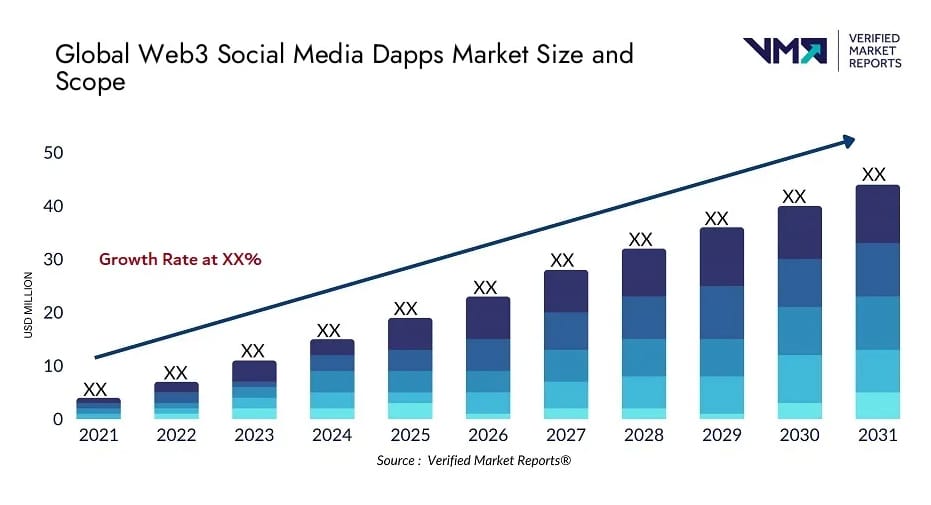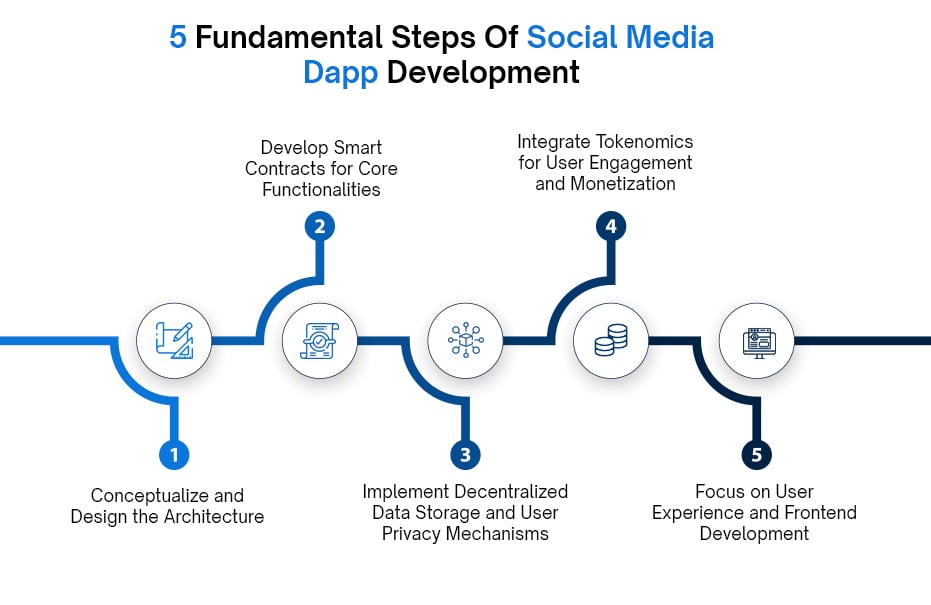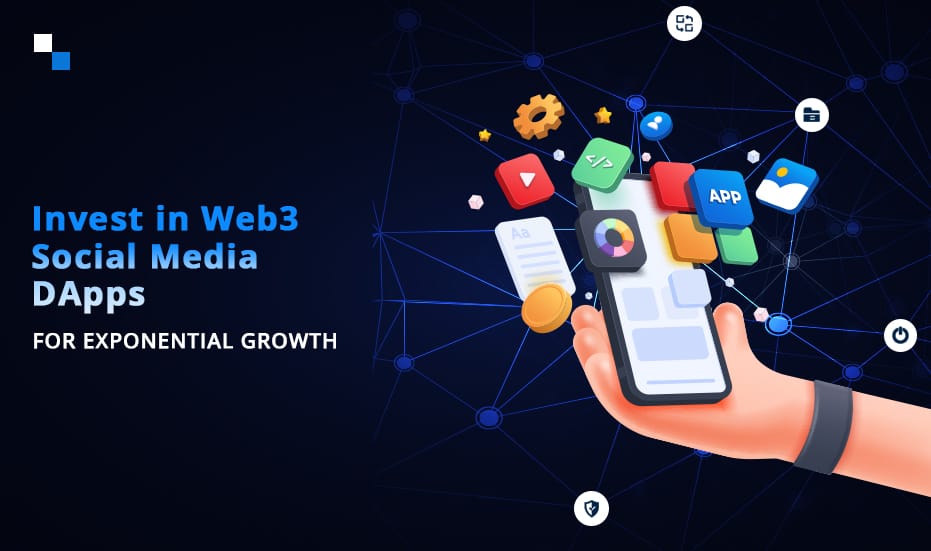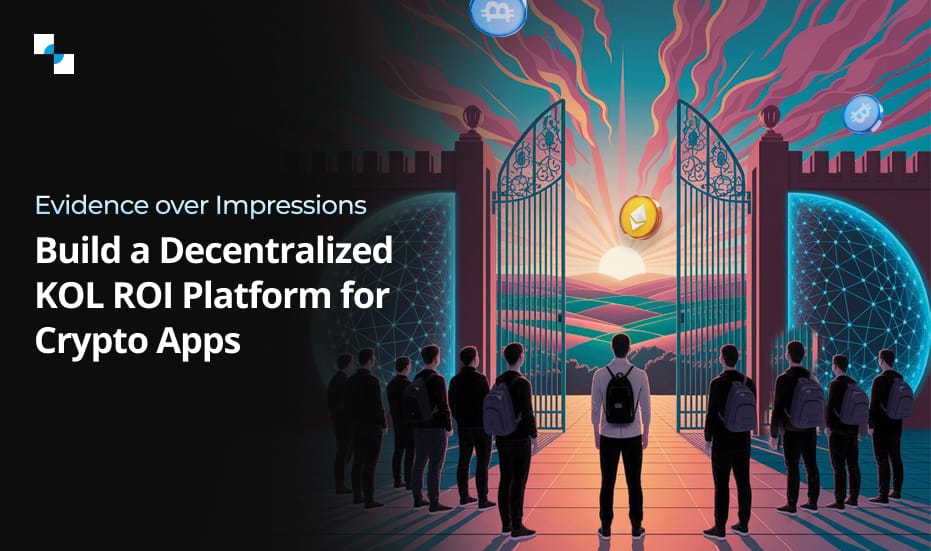Web3 Social Media DApps epitomize the forefront of decentralized communication, redefining the dynamics of digital interaction amidst a profound technological paradigm shift. Anchored in the immutable framework of blockchain technology, these platforms herald a new era of transparency, user-centric autonomy, and resilience against censorship. Far from merely reshaping social connectivity, they are forging groundbreaking financial ecosystems, transcending traditional paradigms. As we approach 2025, the seamless convergence of tokenized economies and decentralized governance elevates these DApps to an unparalleled position of strategic significance, offering visionary opportunities for businesses and investors. Their potential for scalability and transformative impact cements their role as a cornerstone in the accelerating evolution of the Web3 economy.
Let’s Begin!
Social Media dApps: An investment worth it in 2025
Social Media DApps are redefining digital communication by leveraging blockchain’s decentralized architecture to eliminate centralized control. These platforms, deployed on high-performance blockchains like Ethereum, TRON, and Solana, utilize smart contracts for automated functionality and decentralized storage systems such as IPFS for tamper-proof data permanence and censorship resistance. In 2025, Social Media dApps will be technologically advanced, integrating tokenized ecosystems for incentivized participation and Web3 interoperability for seamless cross-platform interactions.
The market size for Web3 Social Media Dapps was estimated at USD 0.4 billion in 2023 and is projected to grow at a compound annual growth rate (CAGR) of 44.9% from 2024 to 2030, reaching USD 5.5 billion by the end of 2030.

Source Link: https://www.verifiedmarketreports.com/product/web3-social-media-dapps-market/
Zero-knowledge proofs and multi-signature cryptographic systems enhance security, ensuring unparalleled data protection. Meanwhile, Layer 2 scaling solutions and modular blockchain architectures optimize throughput and cost-efficiency, enabling these platforms to handle increasing user demand. DID systems and on-chain reputation frameworks that support authenticity and trust make Social Media DApp development solutions the perfect example of how innovation and user empowerment can co-exist. Positioned as the cornerstone of the Web3 ecosystem, they represent a transformative and highly lucrative investment in the evolving digital era.
How Do Social Media DApps Work?
Web3 Social Media DApps operate on blockchain frameworks, leveraging smart contracts to execute automated functions without intermediaries. Fundamentally, these platforms are decentralized, managing data with distributed ledgers such as Ethereum, TRON, or Solana. and transactions. Users access the platform via decentralized wallets, ensuring private key-based authentication and eliminating centralized login systems.
Content and data in Social Media DApps are stored across decentralized storage networks such as IPFS, ensuring censorship resistance and tamper-proof integrity. Tokenized ecosystems incentivize user engagement through native tokens, enabling activities like posting, voting, or sharing. Web3 interoperability protocols allow seamless interaction across other DApps, creating a unified, decentralized experience.
Smart contracts govern all operations, from data sharing to token rewards, ensuring transparency and trust. The network verifies activity through consensus mechanisms, facilitating a transparent, safe, and scalable social media ecosystem.
Distinctive Advantages of Investing In Social Media DApps in The Web3 Era
The Web3 era is defined by decentralized, transparent, and user-empowered technologies, and Social Media DApps are at the forefront of this revolution. By leveraging blockchain-based decentralized architecture, these platforms remove intermediaries and empower users to have full control over their data, creating new dynamics in digital engagement. Every user interaction and piece of content is safe, transparent, and traceable thanks to the immutable ledger that blockchain integration provides. dApp development services concentrate on creating platforms that give end users’ security and autonomy top priority.
- Enhanced Data Sovereignty and User Autonomy: WEb3 Social Media DApps are engineered on blockchain networks, ensuring that user data is decentralized and controlled by users. Through cryptographic techniques and distributed ledger technologies, individuals can manage their digital identities with granularity, minimizing the exposure of sensitive data to central authorities and unauthorized third parties. This decentralized approach ensures a higher level of privacy, mitigating the risks of data breaches commonly associated with centralized platforms.
- Decentralized Monetization Protocols: Social Media DApps eliminate reliance on traditional advertisement-based revenue models by integrating tokenization and smart contract frameworks. These platforms empower content creators to monetize their contributions through direct, peer-to-peer transactions, bypassing intermediaries. By utilizing blockchain’s inherent features, such as NFTs and DeFi mechanisms, DApps create robust and dynamic monetization pathways, offering creators more autonomy over their earnings.
- Increased Transactional Transparency and Verifiability: Blockchain’s immutable ledger ensures that Social Media DApp interactions are transparently recorded. Each transaction, content post, and user interaction is cryptographically sealed, ensuring that these activities are auditable, traceable, and resistant to tampering. This verifiable transparency provides an added layer of trust in decentralized ecosystems, addressing the issues of fraud and manipulation commonly observed in centralized systems.
- Decentralized Governance via Tokenized Voting Mechanisms: Social Media DApps leverage decentralized governance protocols facilitated through tokenized voting systems, enabling users to participate in platform-wide decision-making. Through DAOs, users can exercise control over key decisions such as content moderation, reward distribution, and protocol upgrades. This governance framework ensures that no single entity monopolizes control, thereby aligning platform evolution with community-driven incentives and preferences.
- Interoperability and Cross-Platform Synergy: Built on open-source standards and decentralized protocols, Social Media DApps facilitate seamless integration with other Web3 applications, including decentralized storage systems, DeFi protocols, and NFT platforms. Through the adoption of interoperability standards such as ERC-20, ERC-721, and other token frameworks, DApps provide a cohesive ecosystem where assets, digital identities, and content can be utilized across multiple platforms, creating a richer user experience and enhancing platform utility.
- Censorship-Resistant Architecture: Web3 Social Media DApps are inherently resistant to censorship, as they are not governed by centralized authorities. This decentralization eliminates the single point of failure that often leads to content removal or account bans on traditional platforms. Social Media DApps protect freedom of speech and expression by using consensus mechanisms like PoW or PoS to make sure user-generated content is unchangeable and difficult for centralized organizations to alter or censor.
- Innovative Revenue Streams Powered by Blockchain Economics: The blockchain-powered economies of Social Media DApps offer revolutionary new revenue models such as tokenized microtransactions, reward-based mechanisms, and DeFi integration. These platforms generate open, decentralized economies that compensate users directly for their contributions by tokenizing user engagement and using smart contracts to automate micropayments. This shift in revenue models fosters a more equitable distribution of value within the ecosystem.
- Advanced Security and Privacy Protocols: Social Media DApps employ advanced cryptographic techniques and decentralized consensus protocols to safeguard user data and interactions. Through encryption and the use of ZKPs, these platforms ensure that user information is securely stored and transmitted. Additionally, by decentralizing data storage and eliminating the reliance on centralized servers, DApps drastically reduce the risk of hacks, data leaks, and unauthorized access.
- Global Financial Inclusion via Web3 Economics: Web3 Social Media DApps facilitate financial inclusion by enabling participation in the decentralized economy, regardless of geographical or financial barriers. Through blockchain’s token economies, users from underbanked regions can engage in the global digital economy without intermediaries. This democratization of financial systems allows users to earn, spend, and exchange value in a permissionless, borderless environment, thereby offering more equitable access to economic opportunities.
- Sustainable and Scalable Growth through Decentralized Ecosystems: The decentralized nature of Social Media DApps fosters long-term scalability and sustainability. Through the use of community governance and incentives for network users, such as staking and liquidity provision, these platforms are made to change in response to user preferences and network growth. This robust ecosystem ensures that Social Media DApps remain adaptable to technological advancements, regulatory changes, and market dynamics, ultimately positioning them for enduring success in the Web3 era.
This version incorporates highly technical and advanced language suited for a specialized audience, with an emphasis on the core functionalities, economic structures, and technological advancements of Social Media DApps in the Web3 space.

Foundational Features Of Web3 Social Media Dapps
Web3 social media DApps are at the forefront of digital interaction, combining blockchain, cryptography, and DeFi to reshape user engagement. To ensure success, these platforms must incorporate the following high-impact features that meet the current needs of users and investors:
✔ Decentralized Identity and Authentication: Using blockchain-based identity management, Web3 DApps allow users to control their data and digital presence, eliminating reliance on centralized systems while enhancing security and privacy.
✔ End-to-End Encryption and Privacy-Centric Design: Implementing end-to-end encryption (E2EE) ensures that user communications and data are secure and private, with full control over who sees their information.
✔ Tokenized Reward Systems: Native tokens incentivize user participation, rewarding content creation and engagement. This tokenomics approach fosters platform loyalty and long-term growth.
✔ Smart Contract-Driven Content Moderation and Governance: Smart contracts automate moderation and governance, ensuring transparent and decentralized decision-making, with community-driven policies and dispute resolution.
✔ Interoperability with Web3 Ecosystem: Seamless integration with other decentralized services such as NFT marketplaces and DeFi protocols enhances user experience and platform value by expanding functionality.
✔ Self-Sovereign Content Ownership: Users retain full ownership of their content via blockchain, empowering creators to control distribution and monetize their digital assets.
✔ Decentralized Data Storage: Utilizing decentralized storage systems like IPFS ensures secure, immutable, and redundant data storage, reducing the risks associated with centralized cloud providers.
✔ Layer 2 Scalability Solutions: Implementing Layer 2 solutions like zk-Rollups or Optimistic Rollups enhances scalability, improving throughput and reducing gas fees while maintaining decentralization.
✔ On-chain Analytics and Reputation Systems: On-chain data enables transparent tracking of user behavior and content performance, offering personalized recommendations and fostering deeper engagement.
✔ Cross-Platform Integration with DeFi and NFTs: Integrating DeFi services and NFTs enables in-app transactions, staking, and content monetization, creating a vibrant ecosystem that benefits both creators and investors.
These features ensure a technologically advanced Web3 social media DApp that stands out in the competitive landscape, attracting a broad user base and fostering long-term success.
How to Get Started With Social Media Dapp Development?
A systematic approach is necessary to create a Web3 social media DApp, guaranteeing the integration of decentralized technologies while preserving an easy-to-use, user-focused interface. The following five technical steps outline a proven process that dApp development companies follow to build a successful Web3 social media platform. Each step incorporates industry best practices, aligning with the latest trends in blockchain, cryptography, and DeFi.

Step 1. Conceptualize and Design the Architecture
The first critical step in building a Web3 Social Media dApp is designing a decentralized architecture that will support all platform features. This begins with identifying the core functionalities and understanding the decentralized aspects, including content ownership, user interaction, and governance. Blockchain protocols like Ethereum, Polkadot, or Solana must be chosen based on scalability, security, and transaction speed requirements. Additionally, deciding between on-chain and off-chain data storage and selecting the right DID system is essential.
Step 2. Develop Smart Contracts for Core Functionalities
Smart contracts are the backbone of Web3 Social Media DApp functionality, automating key features like content creation, reward distribution, and governance. These self-executing contracts must be meticulously crafted to define the rules of engagement, such as token rewards, reputation systems, and content moderation. It’s crucial to perform comprehensive testing to ensure security and scalability, as vulnerabilities in smart contract code can lead to significant risks, including financial loss and platform compromise.
Step 3. Implement Decentralized Data Storage and User Privacy Mechanisms
Privacy and data sovereignty are paramount in Web3 Social Media DApps. Utilizing decentralized storage solutions like IPFS (InterPlanetary File System) or Arweave allows for immutable and transparent content storage, ensuring that no central authority can alter or censor data. Users must have complete control over their content, with encrypted communication channels to protect privacy. Implementing end-to-end encryption (E2EE) ensures that private messages and data transfers remain secure and inaccessible to unauthorized parties.
Step 4. Integrate Tokenomics for User Engagement and Monetization
A critical aspect of building a Web3 Social Media DApp is defining a tokenomics model that incentivizes user participation and content creation. Creating a native token or cryptocurrency to compensate users for a variety of actions, including posting, liking, commenting, and curating content, is part of this. Additionally, integrating NFT functionality allows creators to tokenize their content, providing a monetization avenue. Token-based governance models, where token holders have voting power on platform policies, also play a vital role in decentralized decision-making.
Step 5. Focus on User Experience and Frontend Development
Building a seamless and engaging UI is just as critical as the decentralized backend. While blockchain technology powers the backend, the frontend must provide a smooth, intuitive experience to users unfamiliar with the complexities of Web 3. Responsive design, easy navigation, and integration with Web3 wallets are crucial for attracting non-technical users. Moreover, cross-platform accessibility ensures that the Web3 Social Media DApp reaches a broader audience.
dApp development companies can create an impactful and user-friendly Web3 social media platform by following these five steps. This process ensures a balance between technical complexity and user-centric design, providing a robust foundation for the next generation of social media platforms that operate within the decentralized web.
How Much Does It Cost To Build A Web3 Social Media Dapp?
The cost of building a Web3 Social Media DApp is contingent upon various intricate factors that shape the project’s complexity and scale. Primarily, the choice of blockchain infrastructure—whether leveraging high-throughput networks like Ethereum or Polkadot or utilizing cutting-edge Layer 2 solutions—greatly influences the cost. Moreover, the integration of advanced tokenomics models, NFT functionality, and decentralized governance mechanisms through smart contracts necessitates specialized development, impacting the overall pricing. Additionally, implementing decentralized storage systems like IPFS or Arweave for immutable content storage, coupled with robust end-to-end encryption protocols to ensure data sovereignty, adds to the technical expenditure. The caliber and expertise of the dApp development company also determine resource allocation and project timelines, influencing the final investment required for a fully realized Web3 social platform.
Connect With Antier: Develop Social Media Dapps Faster Now!
Antier, a leading dApp development company, pioneers the rapid creation of bespoke Web3 Social Media DApps, leveraging advanced blockchain architectures and decentralized frameworks. Our agile development protocols, powered by cutting-edge technologies like smart contract automation and tokenized ecosystems, enable seamless delivery of scalable, high-performance solutions tailored to your business objectives. Our steadfast dedication to technological superiority and unmatched speed enable businesses to fully utilize the revolutionary possibilities of Web 3. Collaborate with us to transform your vision into an operational reality—faster, smarter, and with unmatched precision. Propel your business into the decentralized era with solutions engineered for impact, agility, and innovation. The future is decentralized—start building it with Antier now!







